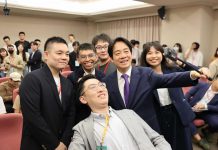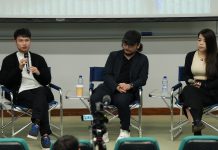In the past five years, more co-working spaces have emerged, providing a hub for freelancers, entrepreneurs and creatives. They are spaces with internet connections, coffee machines, and meeting tables. But fashion designers who need a sewing machine or architects who need to build models still had nowhere to go. It was with this in mind that Harada founded MakerBay in 2015 and built the 600-square-metre creative studio and community space with his team in Yau Tong. In 2016, MakerBay launched an offshoot – a design hub in Police Married Quarters (PMQ), a creative industries centre located in Central.
A year later, it turned out that The Harbour School was inspired by MakerBay and built a creative space on its new premises.
“The staff and the people I trained are technically taking my job,” Harada laughs. “I’m happy I kind of made myself redundant, which is what I always hoped for. I hope I can solve the problem and people won’t need me any more.”
After his time at The Harbour School, Harada now works with a Hong Kong local school, The Mission Covenant Church Holm Glad Primary School. Harada says that this school is special because they tend to accept students who are rejected by mainstream local schools. He has noticed that because the students are not expected to excel academically, they are allowed to be more experimental and creative. “The result is that they have more freedom,” he explains. “So the Maker education became the dominant trait of the curriculum there.”
It is no surprise that as an individual who failed in the mainstream education system, Harada remains unconvinced by its dominant ideology. He feels that Hong Kong is still a conservative society. “If the government and the economic trend make people think that being a doctor, a lawyer, or a financier is a better job, and being a blue collar is humiliating and degrading, it makes sense that most families are going to do all they can to keep their children away from blue collar activities,” he says.
Harada thinks this trend will only create a bigger social divide and “incredible wage discrepancy”. That is why he is trying to bridge the gap through technology, science, and education. Although he has introduced his brand of maker-inspired education to several schools, he has yet to convince mainstream local schools to adopt his curriculum.
However, the current trend for and promotion of STEM education has given Harada the opportunity to work more with local schools. STEM is an approach designed to equip students with skills in the disciplines of science, technology, engineering, and mathematics. The government’s initiatives in this area include handing out funds for schools to reopen their design and technology programmes. However, many schools do not know what to do with the money. “Lots of them don’t know what to do with the hundreds of thousands of Hong Kong dollars,” he explains. “We have solutions for them.”
With increasing support for STEM and design and technology, Harada envisions a world that can accommodate both education and innovation, where both white-collar and blue-collar workers can be respected equally. He would like to see an education system that no longer puts a premium on memorisation and giving the correct answers. He believes that we should not be measuring a child’s intelligence based on numbers and grades, but should be appreciating their unique qualities instead.
“Can you do something that robots can’t do?” he asks. “Being able to work with your hands and work with your creativity – it’s what humans are best at.”
Alluding to the ancient Greeks, the enlightenment era and the Renaissance period, Harada believes that humans have the ability to take on many different roles. Historically, people did not erect boundaries between creative work and technical work, or distinguish intellectual work from spiritual work. Rather, people understood that successful craftsmen needed scientific knowledge while great scientists had to be creative.
He hopes that in the future, humankind can reclaim these traditions. His stake in that future seems bigger now than before. As he talks to Varsity, Harada constantly checks his phone. He quickly fires off a message, not as an environmentalist, an inventor, an entrepreneur, or a teacher this time but as a father.
His wife and their newborn baby are still in San Francisco, part of the reason why he travels back and forth between the United States and Hong Kong. But he hopes to raise their child in Hong Kong in the future.
Surprisingly, the difficulties of raising a child here, given the stressful education atmosphere, do not bother him. “One of the beauties of Hong Kong is that even if you live here, you could live your life in so many different ways,” he says. “It doesn’t mean that just because you’re here, you have to abide by the mainstream.”
For Harada, the point is that humans can solve the problems they have created. It all goes back to the question he asked his audience at the 2012 talk in Doha – what is the common point between oil, plastic, and radioactivity?
“These are man-made problems,” he answered back then, before breaking into his characteristic optimistic smile. “But if we have the power to create these problems, we may have the power to remediate these problems.”
Edited by Verena Tse






































